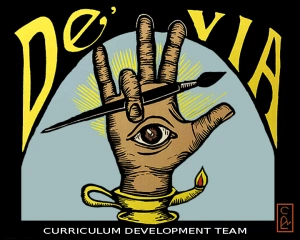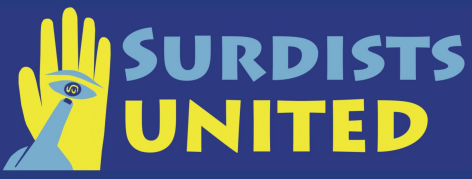Welcome to De’VIA Curriculum!

Welcome! As one of the missions of Surdists United, we are committed to bringing Deaf View/Image Art De’VIA into the classroom and community. The De’VIA Curriculum project began after an artist retreat in Olathe, Kansas in 2013 where 40 Deaf artists gathered to examine the past, present, and posterity of De’VIA. In addition to the creation of a large mural to honor the original 1989 De’VIA mural, which is missing, we proposed to set up a De’VIA curriculum working group. The first one took place in 2014 and has been running annually for one week every summer (click the Background & History for more info on each of the De’VIA curriculum working groups over the years)
Curriculum Goals
The founding principle of the De’VIA Curriculum is that Deaf and Deaf-blind children are entitled to learning about their Deaf heritage, language, struggles and victories, identity and rights via visual arts. With this curriculum they will also learn about traditional elements and principles of art that reinforce national art education standards. This curriculum can be used with Hearing children as more and more public schools are incorporating De’VIA into their American Sign Language (ASL) programs and other subject area curriculum.

The goals of this curriculum are to ensure that Deaf and Deaf-blind students will be introduced to:
- The meaning of Deaf View/Image Art
- The history of De’VIA
- Motifs and Themes in De’VIA works
- De’VIA artists and their works
- The 4 Elements of De’VIA
- Ways to create their own De’VIA works in carrying out these goals, teachers will employ and further develop Deafhood pedagogy practices.
De’VIA Teaching Approach
This De’VIA curriculum is also unique because it employs a Deafhood pedagogy. Dr. Paddy Ladd introduced the concept of Deafhood at the beginning of the 21st century. Deafhood includes the belief that it is good to be Deaf and Deaf-blind. Deafhood challenges audism (the belief that it is superior to be Hearing) and celebrates Deaf Gain (the belief that Deaf and Deaf-blind people have much to offer the world). This De’VIA curriculum is to be taught following Deafhood Pedagogical practices. Below is a list of the overlapping stages of Deafhood Pedagogies, followed by a link explaining each of the stages [See slides 10 – 16 for explanations of each stage] (taken from Ladd, 2013).
The 6 ‘Stages’ of Deafhood Pedagogies
- Developing the ‘cognitive engine.’
- Teaching an appreciation of modalities.
- Creating a safe cultural environment.
- Accelerating language development.
- Identifying Deaf peoples’ ‘place’ in the world.
- Teaching how to live in both Deaf and hearing ‘worlds’
http://deafhoodfoundation.org/vlog/wp-content/uploads/2013/10/Fremont-Deaf-Pedagogies-2013COPYRIGHTED.pdf and video of Paddy Ladd presentiing Deafhood Pedagogies http://deafhoodfoundation.org/vlog/2013/12/video-of-paddy-ladds-deafhood-pedagogies-presentation-now-available/

to see the Curriculum and Lessons as a Draft PDF click here
DRAFT DeVIAcurriculumK-12
The De’VIA Curriculum was founded by Surdists United, Inc.
